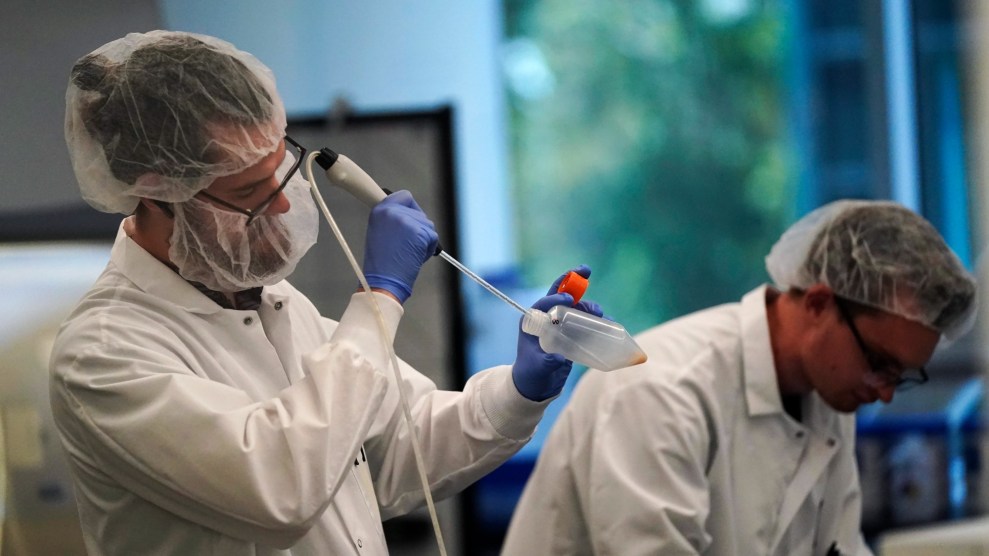New bill takes aim at harmful chemicals found in cookware, outdoor gear and even makeup

By ELISE SCHMELZER | eschmelzer@denverpost.com | The Denver Post
PUBLISHED: March 17, 2024
First, Lisa Cutter removed the carpet from her downstairs level.
As she learned more about PFAS — also known as forever chemicals — she replaced her nonstick pans. Then she started buying dental floss that was free of the harmful chemicals that have become pervasive in modern life.
“The problem is that we can’t keep track of all these things as people,” said Cutter, a state senator from Jefferson County. “It’s too hard. They’re in too many things.”
Cutter and two fellow Democratic lawmakers are running a bill in the state legislature to ban the sale of some consumer products containing PFAS, or per- and polyfluoroalkyl substances — including cookware, outdoor apparel, ski wax and artificial turf. Senate Bill 81’s first draft had also included a full ban on the chemicals beginning in 2032, but the full ban faced enough opposition that it was written out of the bill at its first committee hearing on Tuesday.
The challenges against the bill illustrate the difficulty of regulating PFAS, which have been used for decades to make commercial products waterproof, nonstick or stain resistant. The harmful chemicals are difficult to regulate because they are everywhere, lawmakers and experts said.
They’re used in thousands of consumer products, from skillets to lipstick to jackets coated in Gore-Tex. They’re in some food packaging as well as in rugs and rock-climbing ropes. And they’re used industrially in firefighting foam, hospital floors and microchips.
“The more we look for PFAS, the more we find,” said Gretchen Salter, strategic advisor with Safer States, an organization that works on policy to remove toxic chemicals. “That makes regulating PFAS really tricky, because it is in so many things.”
The chemicals are linked with a wide range of health problems, such as increased cancer risk and lower fertility. They’re also complicated and expensive to remove from water supplies — costs that water treatment companies say will eventually lead to more expensive rates for residents.
Some companies that use PFAS in their products say they would like to transition to a safer replacement but need more time to make that happen. Others say there is no effective replacement in their processes.
The amended bill passed the Senate’s Business, Labor and Technology Committee on a 5-2 party-line vote last week. Cutter said she still wants a complete ban. But she must walk a line between pushing for change and allowing reasonable accommodations for companies and industries.
“As much as I want PFAS to go away forever and forever, there are going to be some difficult pivots,” she said.
Exposure through air, water and food
PFAS is a shorthand term for thousands of different chemicals used in products and industrial processes around the world.
When products and materials containing PFAS are discarded in a landfill, the chemicals seep into drinking water supplies. When they’re incinerated, the chemicals remain in the air. They enter the body when people breathe air or drink water contaminated with PFAS; people can also be exposed by foods they eat — such as fish that swam in contaminated water or dairy products from livestock exposed to PFAS.
Once consumed, the chemicals stay in the body for months or years. Researchers don’t fully understand all the potential health effects. Still, the chemicals could lead to reduced fertility, developmental delays, increased risk of cancer, suppressed immune systems and hormonal changes, according to the Environmental Protection Agency.
“The chemicals were super-useful until we started looking at their toxicity,” Salter said. “But at what cost? That’s what everyone is asking now.”
Colorado lawmakers in 2022 passed a bipartisan bill that banned the sale of carpets, fabric treatments and food packing that contained PFAS, along with other restrictions. The legislation was a significant step forward in the national context, Salter said, because it applied to broad types of products instead of individual items.
But Cutter said she knew it wasn’t enough.
Her bill this year, SB24-081, would establish new deadlines for restrictions or bans:A ban starting July 1 on the installation of artificial turf that contains PFAS.
Starting Jan. 1, 2025, a ban on the sale of cleaning products, cookware, dental floss, menstruation products, ski wax and textiles that contain intentionally added PFAS.
By the same date, sellers must label outdoor apparel made with intentionally added PFAS.
Also at the start of 2025, firefighting foam containing PFAS, already banned in some cases, would no longer be allowed for fuel storage and distribution facilities as well as chemical plants.
Starting in 2028, a ban on the sale of outdoor apparel containing PFAS.
States increasingly are passing laws regulating PFAS, Salter said. The resulting patchwork isn’t consistent, but it sends a message.
“State action really does drive the market,” Salter said. “When enough states have acted, it does move the market.”

Removing chemicals from water is costly
As Colorado lawmakers look at ways to reduce the sources of PFAS, water utilities are trying to clean up existing contamination.
More than 100 drinking water sources in Colorado already have potentially hazardous levels of PFAS, the Colorado Department of Public Health and Environment found in testing in 2020. Federal regulators are considering imposing stricter limits on drinking water contamination, and water treatment managers in the state warn that they likely will have to pass on the cost of removing the chemicals to residents.
Federal environmental regulators last year proposed new rules on the two most common PFAS chemicals. The proposed rules limit the amount of allowable PFAS in drinking water to 4 parts per trillion — equivalent to a drop of the chemicals in 125,000 barrels of water.
“If we can mitigate this at the source, that would probably be the best move forward,” said Libby Hauth, the wastewater treatment manager for Pueblo West Metropolitan District, during the bill’s hearing Tuesday.
Englewood-based South Platte Renew treats 20 million gallons of wastewater every day and is considering implementing reverse osmosis treatment to remove PFAS, said Dan DeLaughter, its data and regulatory programs manager. The treatment would cost $350 million to install, not including the cost of electricity to run the process or to dispose of the resulting brine, he said.
The company’s typical annual capital expenditures add up to $15 million, he said.
“There are no easy buttons with PFAS,” DeLaughter said.
The potential for higher water rates is one of the reasons Cutter is pursuing more regulation — especially as water supplies become stretched by drought that’s fueled by climate change.
“I’m not as concerned about corporate profits taking a ding, because should the taxpayers be on the hook for that?” Cutter said.
Overly broad and non-scientific?
Lawmakers heard from representatives of several industries Tuesday, and they asked for more time to sell through their existing stock of products facing bans. Burning or trashing products with PFAS is wasteful and doesn’t prevent the chemicals from entering the environment, they said.
“Products that can’t be sold don’t simply disappear,” said Shannon Fender, senior manager of state government affairs for Denver-based VF Corp., which owns outdoor apparel brands including The North Face, Vans and Smartwool.
Companies that use PFAS to manufacture semiconductors and electric vehicle wiring also asked for leniency because there are no substitutes for the chemicals in their processes.
“There are critical uses for PFAS that are going to be hard to replace with other chemicals — those will take more time,” said Timm Strathmann, a Colorado School of Mines professor who researches PFAS. “Then there are products where we already have viable alternatives.”
The American Chemistry Council, which represents the chemical manufacturing industry, went even further and argued that not all PFAS are harmful and should be regulated individually.
“SB-81’s overly broad and non-scientific approach undermines efforts to implement effective regulatory policies for PFAS. it will have far-reaching negative effects on the economy,” Shawn Swearingen, the council’s director of chemical products and technology, told lawmakers.
Cutter says she’s not interested in parsing harmful PFAS from those some say are not harmful. She’s also standing firm on the types of products she wants to be PFAS free but is open to negotiating timelines.
She wants to put companies on notice: Even if their products containing PFAS aren’t included in this round of legislation, they will be at some point.
“I don’t know what that date would be, but there’s got to be some sort of a ban eventually,” Cutter said. “They’re proven to be harmful to human health, there’s no question about that.”













